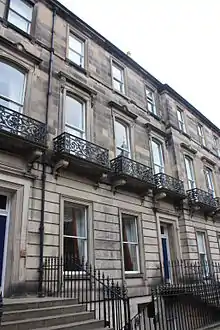Benjamin Blyth II
Benjamin Hall Blyth FRSE (25 May 1849 – 13 May 1917), often called Benjamin Blyth II, was a Scottish civil engineer.[1]
 | |||||||||||||||||||||||||||||
| Birth name | Benjamin Hall Blyth | ||||||||||||||||||||||||||||
|---|---|---|---|---|---|---|---|---|---|---|---|---|---|---|---|---|---|---|---|---|---|---|---|---|---|---|---|---|---|
| Date of birth | 25 May 1849 | ||||||||||||||||||||||||||||
| Place of birth | Edinburgh | ||||||||||||||||||||||||||||
| Date of death | 13 May 1917 (aged 67) | ||||||||||||||||||||||||||||
| Place of death | North Berwick, East Lothian | ||||||||||||||||||||||||||||
| School | Merchiston Castle School | ||||||||||||||||||||||||||||
| University | University of Edinburgh | ||||||||||||||||||||||||||||
| Notable relative(s) | Benjamin Hall Blyth I Mary Dudgeon Wright (parents) | ||||||||||||||||||||||||||||
| Spouse | Millicent Taylor | ||||||||||||||||||||||||||||
| Children | Benjamin Edward Blyth Elsie Winifred Blyth | ||||||||||||||||||||||||||||
| Rugby union career | |||||||||||||||||||||||||||||
| |||||||||||||||||||||||||||||
| 3rd President of the Scottish Rugby Union | |||||||||||||||||||||||||||||
| In office 1875–1876 | |||||||||||||||||||||||||||||
| Preceded by | Albert Harvey | ||||||||||||||||||||||||||||
| Succeeded by | William Hamilton Kidston | ||||||||||||||||||||||||||||
| |||||||||||||||||||||||||||||
Family
Blyth, who was born at 36 Minto Street,[2] Edinburgh,[3] was the eldest of the nine children of Mary Dudgeon Wright and the railway engineer Benjamin Blyth.[1] He was educated at Merchiston Castle School between 1860 and 1864 before studying for a Master of Arts degree from the University of Edinburgh, graduating in 1867.
After the death of both parents – Benjamin Blyth in 1866 and Mary Dudgeon Wright in 1868 – Blyth and his siblings were brought up by their mother's sister, Elizabeth Scotland Wright.[4][5]
Rugby Union career
Amateur career
Blyth played for Merchistonians.[6]
Provincial career
Blyth played in the world's very first representative provincial match in November 1872. This was the 'Inter-City': the match between Glasgow District and Edinburgh District. Blyth represented the Edinburgh side.
Administrative career
He became the 3rd President of the Scottish Rugby Union, holding the post between 1875 and 1876.[7]
Engineering career
Following his father's death, Blyth entered the family engineering consultancy and became a partner five years later. Blyth served as a consultant to the North British Railway and the Great North of Scotland Railway and served in an advisory capacity to the British Army with the rank of Lieutenant-Colonel in the Engineer and Railway Staff Corps. In 1872, he married Millicent Taylor[8] with whom he had a son, Benjamin Edward, who died in infancy,[9] and a daughter, Elsie Winifred.[1] He became a member of the Institution of Civil Engineers in 1877, being elected to its council in 1900. He served as vice-president in 1911 and in 1914 became the first practising Scottish engineer to serve as president.[10] On 7 February 1898 he became a Fellow of the Royal Society of Edinburgh.[11]
Political career

In later life, Blyth lived in a large Victorian townhouse at 17 Palmerston Place in Edinburgh's West End.[12]
Blyth stood as the Unionist candidate for the East Lothian by-election of 1911, but lost to the Liberal candidate, John Deans Hope by 468 votes. One of his policies was opposing giving home rule to Ireland.[13]
Death
Blyth was widowed on 12 September 1914. He died in North Berwick on 13 May 1917, of "spittielioma of tongue"[14] and was survived by his daughter. His nephew, Benjamin Hall Blyth (sometimes referred to as Benjamin Blyth III) was the son of his brother Francis Creswick Blyth – who was taken on by Blyth and Blyth in 1909,[15] continued the consultancy after his death.[1]

He is buried on the obscured southern terrace of Dean Cemetery in Edinburgh, towards the east. His wife, Millicent Taylor (1852-1914) is buried with him. Their infant son, Benjamin Edward Blyth, who died in 1875 aged six weeks lies at their feet.
Legacy
He trained James Simpson Pirie FRSE (1861-1943), founder of J S Pirie & Sons. Pirie ran Blyth & Blyth from his death until the end of the war.[16]
References
- "Dictionary of Scottish Architects entry". Archived from the original on 19 July 2011. Retrieved 5 January 2008.
- Edinburgh Post Office Directory 1849
- Old Parish Record of birth
- Will of Mary Dudgeon Wright, held by Scottish records
- Census of Scotland 1871
- https://news.google.com/newspapers?id=hY9EAAAAIBAJ&sjid=b7UMAAAAIBAJ&pg=5954%2C5078015
- https://s3-eu-west-1.amazonaws.com/sru-files/files/SR_RR1819_digital.pdf
- "Archived copy" (PDF). Archived from the original (PDF) on 19 September 2015. Retrieved 23 April 2015.CS1 maint: archived copy as title (link)
- Blyth, E.L.I. 1893, The family of Blythe or Blyth of Norton and Birchet
- Watson, Garth (1988), The Civils, London: Thomas Telford Ltd, p. 252, ISBN 0-7277-0392-7
- Royal Society of Edinburgh fellows list Archived 4 October 2006 at the Wayback Machine
- Edinburgh and Leith Post Office Directory 1905-6
- The Scotsman, various editions from 1911
- Death certificate, held by Scottish records office
- Blyth and Blyth: The First 100 Years, historical records held by company
- "Dictionary of Scottish Architects - DSA Architect Biography Report (May 26, 2019, 3:37 pm)". www.scottisharchitects.org.uk. Retrieved 26 May 2019.
| Professional and academic associations | ||
|---|---|---|
| Preceded by Anthony George Lyster |
President of the Institution of Civil Engineers November 1914 – November 1915 |
Succeeded by Alexander Ross |
